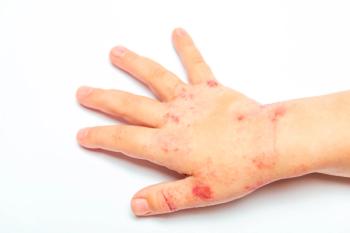
- Consultant for Pediatricians Vol 10 No 3
- Volume 10
- Issue 3
Tinea Faciei
A 7-year-old boy was brought for evaluation of a rash on the chin that had appeared 2 weeks earlier. It was slightly itchy. The mother had applied a topical corticosteroid for a few days but then stopped because of worsening of the lesion.
A 7-year-old boy was brought for evaluation of a rash on the chin that had appeared 2 weeks earlier. It was slightly itchy. The mother had applied a topical corticosteroid for a few days but then stopped because of worsening of the lesion.
The erythematous, scaly lesion with a well-defined border on this boy's face is characteristic of tinea faciei. As the lesion spreads peripherally, the center often clears and produces the classic annular lesion that is responsible for the designation of ringworm. Microscopic examination of a potassium hydroxide preparation of scrapings from the lesion showed numerous septate hyphae. This confirmed a dermatophyte infection; culture can also establish the diagnosis. Scrapings from scales at the edge of the lesion produce the best results.
Trichophyton rubrum, Trichophyton mentagrophytes, Trichophyton tonsurans, and Microsporum canis are the most prevalent causative organisms.1 Rarely, tinea faciei can be caused by Microsporum gypseum.2 Occasionally, tinea faciei may simulate polymorphous light eruption, seborrheic dermatitis, contact dermatitis, impetigo, discoid lupus erythematosus, and acne rosacea.2,3
Tinea faciei usually responds to application of a topical antifungal agent, such as micronazole, ketoconazole, econazole, naftifine, or terbinafine. In difficult-to-treat cases, oral itraconazole or fluconazole can be considered. This child was treated with topical terbinafine. The lesion resolved within 10 days.
References:
REFERENCES:
1. Leung AKC, Robson WLM. Tinea faciei. Can J CME. 2006;18(10):73.
2. Criado PR, Costa AR, Vasconcellos C, et al. Tinea faciei in an infant caused by Microsporum gypseum simulating a dry impetigo. Pediatr Dermatol. 2005;22:536-538.
3. Gorani A, Oriani A, Cambiaghi S. Seborrheic dermatitis-like tinea faciei. Pediatr Dermatol. 2005;22:243-244.
Articles in this issue
almost 15 years ago
Newborn With Urinary Dysfunctionalmost 15 years ago
Car Seat Phobia: Where It May Stem From, How to Correct Italmost 15 years ago
Would you continue acne therapy for a teenage boy with severe scarring?almost 15 years ago
Infant With Persistent Fever and Fussinessalmost 15 years ago
The Uncontrollable Child: Family and Educational Interventionsalmost 15 years ago
Unexpected Finding in Young Girl After Arm Injuryalmost 15 years ago
Molluscum Contagiosum on the Face of a 4-Year-Old Boyalmost 15 years ago
Baby Boy Cries With One Eye Openalmost 15 years ago
Aplasia Cutis Congenita With Associated Fetus PapyraceusNewsletter
Access practical, evidence-based guidance to support better care for our youngest patients. Join our email list for the latest clinical updates.








